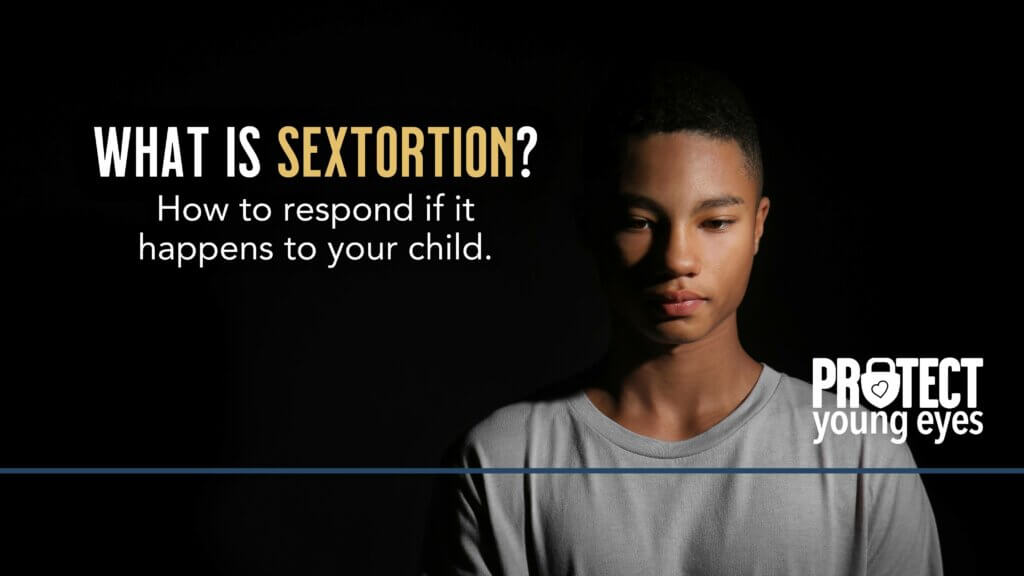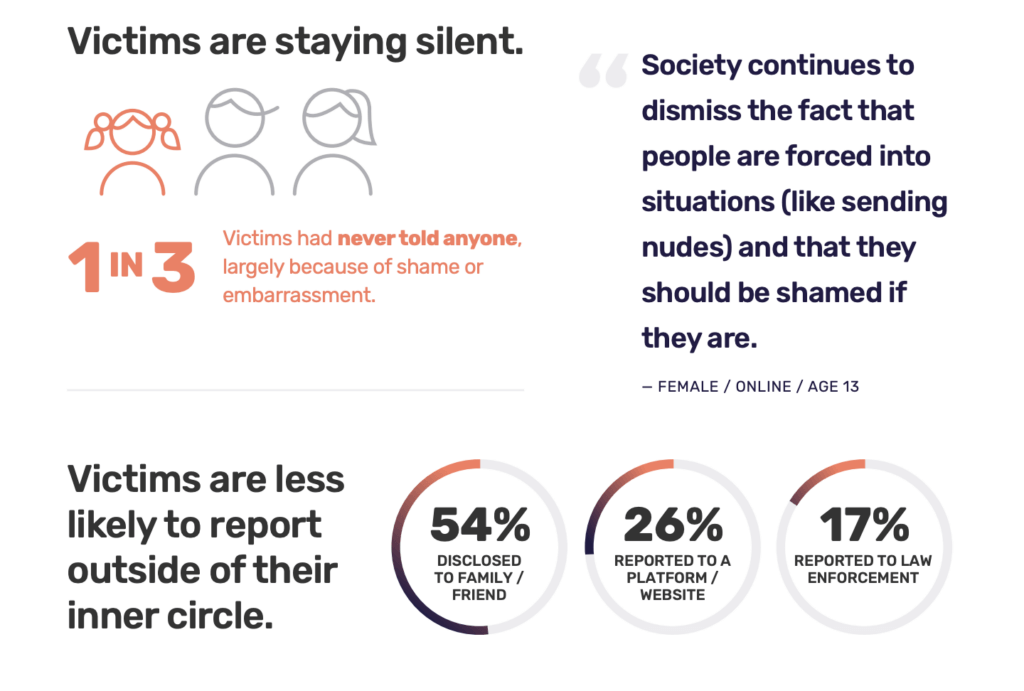Sextortion is on the Rise
Within the past three weeks, I’ve had two different families reach out to me with dire sextortion situations. In both cases, these were older kids! Ages 17 and 18, respectively. In other words, sextortion isn’t just a young kid issue.
- A stranger approached him on Discord, videoed him in sex acts, then told him to pay or she’d post his video on Instagram and email all his friends.
- He paid a few hundred dollars, all he had, but they wanted more.
- He asked his mom for help and she paid a few hundred more. The bad guys still want more.
What would you do in this situation? Fortunately, in both of these cases, parents intervened before more damage was done. But sadly, that isn’t always the case. Our founder has also had interaction with families whose children have died by suicide because of the extreme pressure exerted on them, with threats of embarrassment. Jordan DeMay from Marquette, MI is a well-known case. He is one of over a dozen young men who have been victims of this horrible crime.
What is Sextortion?
Here are common steps in a sextortion scheme:
- ➡️ Perpetrator sends an anonymous DM to hundreds of teens, looking for responses, using fake accounts. Sometimes grooming happens over an extended period, earning trust. There’s a promise of an exchange of some kind, most often “You send me something explicit of you and I’ll send something from me.”
- ➡️ Eventually, some teens send a nude photo/video.
- ➡️ The perp then demands money with threats to share the photo/video with family and friends.
- ➡️ The abuser exerts extreme pressure and manipulation on the child.
- ➡️ Outcomes: The child sends money, does nothing, or in some cases, takes their own life.
Data from the National Center for Missing and Exploited Children during 2022 cases makes it more tangible:
✔️93% of the VICTIMS are males.
✔️Abusers are most often out of Ivory Coast and Nigeria. Driven by an appetite for extreme violence and complete disregard for your child. Rewarded if a child commits suicide.
✔️1800% increase in NCMEC reported cases in 2022 compared to 2021.
✔️Victims are most often ages 15-17.
✔️51% of victims were sextorted through Instagram.
✔️31% of victims through Snapchat.
In other words, sextortion is an exercise in coercion. Imagine your teenage son or daughter receiving a text message like this (this is the actual exchange between “Dani,” a man who extorted Jordan DeMay from Marquette, MI. Jordan ended up dying by a self-inflicted gunshot wound in his bedroom):

What would your son or daughter do? Does he or she have the tools and the wisdom to handle a message like this?
Sextortion Happened to a Friend
Early one morning, I received a text from a friend who is very familiar with my Internet safety work at Protect Young Eyes. She said we needed to speak urgently, so I called her on my way to work.
She shared that the night before, her 13-year-old son Bryce [name changed] had sent a nude photo of himself to a stranger on social media. This stranger had randomly reached out to her son via DM (direct message) and started a friendly conversation. The messages quickly turned to mean, and the person threatened to hurt Bryce’s family if he didn’t send a nude photo. Bryce froze with fear and sent a photo that he knew was wrong, but he just reacted. Next, the stranger told Bryce that if he didn’t give his mom’s credit card number, he was going to post the photo on multiple social media platforms.
At this point, Bryce woke up and told Mom what was happening.
Mom and I discussed the next steps. We got law enforcement involved. It wasn’t fun. Even though all physical doors to the house were locked, it was a digital doorway that gave a bad player access to her son. Or, consider this quote from John DeMay, Jordan’s father:
“My son was smart. He was a good student. He was a great athlete,” John DeMay, Jordan’s father, told Fox News Digital in a previous interview. “Someone came to his bedroom at 3 in the morning and murdered him through Instagram when we were all sleeping at night, and we had zero chance to stop it.
Thorn Surveyed 2097 Sextortion Survivors
Thorn reported a sextortion survey that closely examines the experiences of minors. Here are a few of their findings:
- Approximately 60% of participants were ages 13 and younger when threatened, and slightly more than 50% of participants aged 14, did not know their offender offline.
- Conversely, teenage participants ranging in age from 15-17 were the most likely (57%) participants to be threatened by an offender they knew offline.
- Across the sample, threats were made frequently, with nearly half (47%) of participants reporting being threatened daily, and repeatedly, with more than half (52%) of participants reporting receiving threats between 1 and 9 times per day.
- In nearly 1 in 3 cases, offenders carried out or attempted to carry out threats against the victim. Threats were more often carried out when the offender and victim knew each other in person (38% of the time) compared to those who knew the perpetrator online (20% of the time).
This screenshot from the Thorn study is a wake-up call to parents and caregivers to swing the doors of conversation wide open so that shame is crushed:
Why Do Good Kids Fall Victims to Sextortion?
These are all good kids. But this issue preys on young brains. Here’s why teens are particularly vulnerable to sextortion:
- The limbic system is particularly active in adolescent brains. It’s the emotional and arousal response region. It often responds faster than the more rational brakes of the brain (the pre-frontal cortex).
- In a graphic, here’s how the brain might respond to a sextortion scheme:

Four Steps Parents Can Take to Prevent Sextorton
If a child has an internet-connected device and social media, it’s impossible to fully eliminate the risk of sextortion. But there are steps you can take to lower the risk of occurrence, including the following:
- Be ridiculously direct with your tweens and teens about this issue. Say things out loud that grab their attention and make them think (engaging that front part of the brain) about the gravity of the situation. Phrases like, “Son, listen, don’t ever send a picture of your penis to someone. No dick pics. Got it?” I know it’s crass, but you need their full attention.
- Practice, practice, practice different sextortion scenarios. All of them should direct them back to you and you promise to remain calm. Consider watching the THRON video below with your kids. Also, Thorn has a sextortion counseling line, which can help de-escalate a potential sextortion situation. Just have your child text the word Thorn to 741741 – maybe program this in their phone.
- Control nighttime internet use. Use monitoring software if necessary – like Apple’s Screen Time, Android’s Family Link, or paid solutions like Bark. To prevent access to burner devices (old iPhones, Androids that still work on WiFi), ensure you have a home router that prevents unrecognized devices from using the WiFi. We recommend Gryphon (if routers are confusing, no problem, we’ve written a helpful guide).
- Be fully aware of the apps they are using. Full access to the App Stores to download different messaging apps probably isn’t necessary. In both Screen Time (iPhone) and Family Link (Android), parents can approve app downloads.
Here are two Instagram posts where we talk more about the direct, relational approach mentioned in #1 above:
**WAIT, Chris, my kid has already been the victim of sextortion, how should we respond?
Here are the steps we share with families:
- The “bad guys” are often more talk than action. But when you’re stuck in the middle of it, that’s often very little consolation. Time is money, so if you ignore their pressures, they will often move on to the next person (although no one can guarantee this). As a result, I often advise families NOT to pay money. No matter how much they threaten.
- Report the user on whatever social media platform it happened on. This step is not applicable if it occurred via texting. Here is an amazing list of “how to” for the major platforms from Darren Laur.
- Take screenshots of chats, profiles, and anything else that might be useful if law enforcement gets involved.
- Remove the person from your followers (Instagram) or friends (Snapchat) quickly. Ignore all friend and follower requests for at least 2-3 days.
- You might choose to report the incident to local law enforcement. But sadly, except for the worst situations, they don’t have many tools at their disposal to do much.
- The person might follow through with the threat and create a group DM on Instagram. This would likely be a DM group with whoever is toward the TOP of your followers list because the person threatening you often takes screenshots of a few screens of your followers. Fortunately, Instagram hides attached photos from individuals whom the recipient doesn’t know until the recipient taps on them. Since these spam-like messages happen to all of us, fortunately, many people delete them first, which is of course what all parents and teens hope happens in these situations.
- (Thank you, White Hatter Team for this suggestion) Set up Google Alerts https://www.google.com/alerts – you will need a Gmail account to use this tool. In the Google Alerts search bar, type your name in quotation marks “John Smith”. By doing this, Google will search your full name every day and if the nude gets posted/reposted and tagged with your name on the visible web (the web we all use daily), Google will likely pick up on it and send you an alert to your Gmail account. If you get an alert, click on it and make sure it is you. If it is your nude, you will now know where it is being hosted online, and can then make an application to have it taken down as child sexual abuse material if you are under the age of 18.
- Finally, there’s a new tool from The National Center for Missing and Exploited Children called Take it Down. This might sound scary, but it’s where a family or a teen (or even a young adult) can upload the photo that was shared and NCMEC creates an anonymous “hash” identifier for the photo. This hash is like a fingerprint and if that fingerprint shows up in any other platform that uses hashing then the NCMEC tool automatically reports it and “takes it down.”
Final thoughts about sextortion.
For a child caught in the middle of this issue, it is terrifying. They need your calm. In our experience, during a situation like this, children need to know immediately that (1) they’re going to be okay, and (2) that you’re still okay with them.
What if I have more questions? Where can I ask those?
Ask your questions in our private parent community called The Table! It’s not another Facebook group. No ads, no algorithms, no asterisks. Just honest, critical conversations and deep learning! For parents who want to “go slow” together. Become a member today!

*Disclosure: Some of the links in this post are affiliate links, meaning, at no additional cost to you, we will earn a commission if you click through and make a purchase. We constantly test products to make sure we only recommend solutions that we trust with our own families.

Chris McKenna, Founder: A man with never-ending energy when it comes to fighting for the safety and protection of children. Chris practices his internet safety tips on his four amazing children and is regularly featured on news, radio, and podcasts for his research. His 2019 US Senate Judiciary Committee testimony was the catalyst for draft legislation and ongoing discussion that could radically change online child protection laws and earned PYE the NCOSE Dignity Defense Alert Award in 2020. The PYE team has performed over 1,700 presentations at schools, churches, and nonprofits and was featured in the Childhood 2.0 movie. Other loves include running, spreadsheets, nature, and candy.




Do you have a list of questions to ask your kid (like a script) if you think something’s wrong but aren’t sure what’s happening?